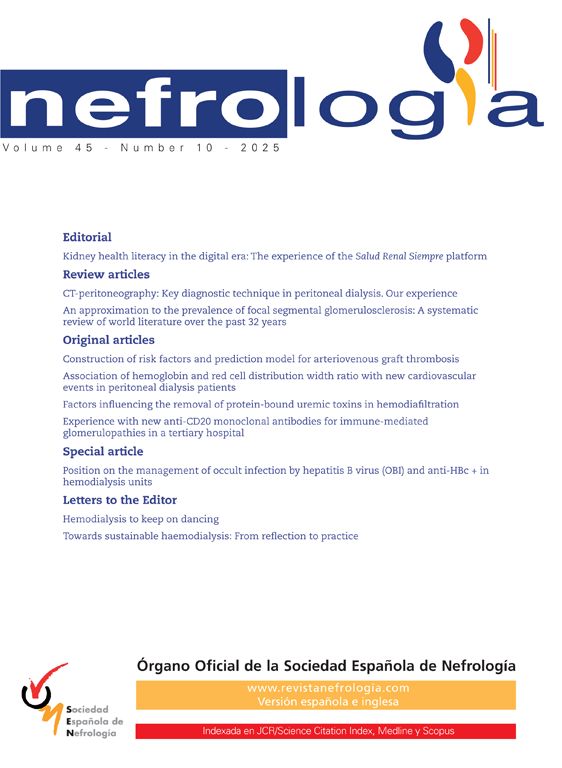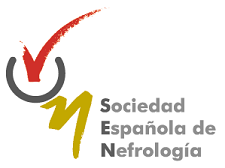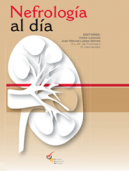INTRODUCTION
Telemedicine is defined as «the application of information and telecommunication technologies to provide medical services, either care, continued medical training, or health education, regardless of the distance to the place where patients with their clinical records or professionals of the temporal variable are».1
This highly valuable tool, born in the field of telecommunication and telematics, provides us with the possibility
of seeing patients in their usual environment, getting medical specialties, nephrology in our case, closer to patient
homes. In addition, a more direct relationship is established between two healthcare levels, primary care and specialised care.
Despite the great advances in recent years in computer science and computer interconnection networks, there is little experience in use of telemedicine for medical consultation. While some studies have been published in the field of hypertension, the literature found about telemedicine in nephrology is scant, and we do not know of any group currently using in Spain this modality of medical consultation for patients with kidney disease.2-6 Reports do exist about renal failure patients on renal replacement therapy, both haemodialysis and peritoneal dialysis.7-18 Various experiences in teleassistance in other medical specialties have also been reported.19-23
In 2004, based on sociodemographic criteria and in order to constantly improve healthcare quality, this work tool was incorporated into the portfolio of services of our section. The purpose of this publication is to assess the value of telemedicine for monitoring patients with renal diseases, getting nephrology closer to primary care in a health area, such as ours, where geographical distances are long and transport to the hospital, where the nephrology practice is located, usually involves high healthcare costs and, in working patients, also loss of working time in many cases (fig. 1).
MATERIALS AND METHODS
A descriptive, retrospective study of patients with kidney disease followed up at the telenephrology clinic of our hospital from November 2004 and January 2007, a total of 27 months.
The Cáceres health area covers a population of 183,129 inhabitants. The study was conducted in centres of this area that were included in the telenephrology programme. This consultation modality was used for four centres of the health care area, covering a total population of 22,721 inhabitants (Trujillo 11,059, Logrosan-Cañamero 3,592, Guadalupe- Alia 3,500, and Valencia de Alcántara 4,570). Consultations were one day per week with two of the centres each day. The estimated duration was three hours, and the ideal, maximum number established of patients appointed per day was nine.
The communication platform used for consultation with the different health centres was the Intranet hospital network, based on Ethernet star networks.
Workstations for the consultations were available at both the hospital and each of the primary care centres, each including a computer and printer and a number of peripherals (document scanner, digital camera, and microphones). Videoconference system. Scanner and certified monitor for X-ray films. Consultation is conducted from the hospital workstation by the nephrologist in charge of telenephrology and a nurse, who is in turn the telemedicine coordinator in our health area, and from the health centre by the appropriate primary care physician (PCP) and the nurse in charge of telemedicine at the corresponding centre. The clinical history is taken in a computerised electronic format and protected with access and confidentiality codes.
Before telenephrology was implemented, meetings were held with the PCPs and nurses from the centres with which
collaboration was planned. A consensus was reached about work procedures, including laboratory tests and other supplemental test to be performed. A first consultation was defined as the first time patients were seen at the telenephrology office, even if they had been referred from the nephrology outpatient clinic of the hospital. No specific referral criteria were established for this office. The referral criteria agreed on with primary care and which have been used in our section for the conventional clinic since 2003 were applied (tables I and II). All patients attending the office were requested the following laboratory tests: complete blood count, blood chemistry including
urea, creatinine, uric acid, glucose, sodium, potassium, complete lipid profile, GOT, GPT, GGT, total protein,
albumin, alkaline phosphatase, acid-base balance. In patients with CRF, laboratory tests also included a complete iron profile, calcium phosphorus, and PTH. In 24-hour urine, urea, creatinine, sodium, potassium, proteinuria, and microalbuminuria. In patients with HBP, a chest X-ray and ECG were also performed. Renal ultrasonography is also available at one of the health centres, that performs the examination for another two centres. Referral was defined as sending a patient to a different practice for evaluation of another associated disease different from the nephrological condition, or for performance of supplemental tests that are not available for teleconsultation at health centres. Voluntary dropouts were assessed as the only criteria for dissatisfaction with this consultation modality.
The operating circuit of telenephrology is as follows (fig. 2): the primary care physician starts the system by preparing a referral document to the office including data from the clinical history, physical examination, and laboratory tests or supplemental tests performed to the patient and justifying consultation by telenephrology. Blood and urine samples are taken at health centres to be sent to the relevant reference laboratory. Health centres included in the telenephrology programme also perform general radiology, electrocardiogram, and eye fundus examination, and also centres are also able to perform abdominal ultrasonography. All this information is subsequently entered into a computer database that arrives via Intranet to the hospital, from which the telenephrology office provides a real time answer to the issue raised backed by a videoconference system. All patients seen in a given day are provided a medical report of the consultation made that is access-protected with confidentiality codes and electronic signature.
RESULTS
During the study period, November 2004 to January 2007 (27 months), there was a total of 105 first consultations, leading in turn to 47 subsequent consultations. Of patients seen, 52 were males and 53 females. Age ranged from 15-94 years (71 ± 17.1). Patients older than 65 years accounted for 66.6% of all patients seen. Incorporation of patients and new health centres was gradual. The programme was started in November 2004 with the first centre, the second centre was incorporated in October 2005, and the remaining two centres entered the programme during 2006, so that the greatest number of patients were seen after all centres were included. Eight consultations were made in 2004 (two months), twelve in 2005, eighty in 2006, and five in the only month of 2007 analysed.
Table 3 shows the diagnoses made at the telenephrology office. Several diagnoses were made in several patients. Most patients with diabetic nephropathy, 14 (82.3%), had stage 5 disease, one patient was in stage 4 (5.8%), and two (11.7%) in stage 3. Among the six patients with chronic glomerulonephritis studied, an etiological diagnosis could be made by renal biopsy, performed at the hospital, in four cases with the following results: 2 extracapillary glomerulonephritis and 2 IgA mesangial proliferative glomerulonephritis. A subgroup of CRF causes given in Table 4 was analysed. Of the 90 patients with HBP, 82 had essential hypertension and 8 secondary hypertension. HBP had a parenchymal renal origin in 5 patients, a renovascular origin in 2 patients, and was due to primary hyperaldosteronism in the remaining patient. Risk factors seen to be associated to HBP included dyslipidemia (29 patients), diabetes mellitus (29 patients), hyperuricemia (11 patients), and obesity (12 patients). No emerging risk factor was found. Several patients seen at the telenephrology office had more than one vascular risk factor. Ametabolic syndrome was also diagnosed in seven patients according to the ATP III criteria.
Twenty patients had to be referred to hospital. Table 5 gives the reasons for referral.
Among the total 105 patients seen during the time period analysed, three dropped out voluntarily from the telemedicine office and returned to the conventional office.
DISCUSSION
There has been in recent years a true revolution in the field of computing that has logically spread to the field of medicine. However, neither specialised nor primary medical care have possibly made the most of this opportunity. Nephrology has been no exception. The possible reasons for this poor use of such an opportunity would include, among others, the lack of support from the administration to implement such advances. There is no doubt that use of certain medical software in standard clinical practice involves an added financial cost that makes its widespread application difficult. There are currently multiple architectures and topologies of communication networks available to implement a telemedicine practice. The network used in our case was selected based on technical, financial, and operational feasibility criteria, and also on the data transmission coverage required.
In the Cáceres health area, telemedicine was started in 2002, but it was not systematically used in our region until
the beginning of 2003. In 2004, based on sociodemographic criteria and in order to constantly improve healthcare quality, this work tool was incorporated into the portfolio of services of our section. The initial plan was to create a hypertension practice covering four health centres. Over time, and with successive incorporation of patients into the telenephrology practice, this not only cares for patients with arterial hypertension, but has been gradually converted into a general clinical nephrology practice.
There is limited experience with telemedicine in some specific area of nephrology, specifically in renal failure patients on renal replacement therapy. Pioneering work in this field was done in Australia11 and the United States10 by connecting peripheral centres to a central hospital. Studies subsequently published in Canada12 and Greece13 reported use of telemedicine applied to home haemodialysis. Teleassistance has been used in the field of HBP, and some group has shown an improvement in diagnosis of essential HBP as compared to conventional care.2-4
Despite the fact that peritoneal dialysis (PD) is currently the home dialysis procedure par excellence, telemedicine has also been little used in such cases.14,16-18 In Japan it has been used in elderly patients.14 In Spain, the nephrology group from Hospital Severo Ochoa in Leganés recently reported its experience to assess the value of this tool in follow-up of their peritoneal dialysis patients.16,17 This group showed that teleassistance is feasible in stable patients on peritoneal dialysis programmes with health transport savings. Patient response was also favourable.
No publications have been found in the literature reporting the results of any group applying telemedicine to the
care of patients in a nephrology practice. Publication of these results demonstrates that telemedicine may be implemented, with no impairment in the quality of care reported by either the care teams or patients seen. While a survey was not conducted to assess patient satisfaction with this consultation modality, we think that the low rate of dropouts and voluntary return to the conventional practice is an indirect proof of such satisfaction. The only reason given for patients was that they preferred direct contact with the specialist, rather than through a monitor.
It should be noted that the work organisation established allows for performing virtually all laboratory tests required in a conventional nephrology clinic at health centres. In our case, plain X-ray films and electrocardiograms may also be done. Through an abdominal ultrasonography programme implemented by the Extremadura health service (SES) in primary care, this examination is also available at health centres themselves or at some near reference, which shortens the distance to be travelled for the test. As a result, we have achieved that patient referral to the hospital for supplemental tests is also very low. All this logically leads to a partial relief of the saturation of central services and an improved use of resources. In a work setting such as ours, where patients have to travel long distances from their homes to the nephrology clinic of the hospital and are mainly elderly (66.6% over 65 years of
age in our series), a reduction has been achieved in the number of transfers, with the subsequent savings in healthcare transport. The reduction in the number of hospital visits has also contributed to reduce the waiting list. In working patients, time lost from work may be decreased. We think that from the financial viewpoint this represents savings for the healthcare system that compensate for a great part of the effort made to implement telemedicine. Obviously, this latter aspect may be subject to a more detailed financial study that is not provided here.
One of the planned objectives of this review was whether this modality of nephrology consultation allows for an effective, closer collaboration of the primary care and specialised care levels. Most nephrologists think that a specialty, such as ours, that cares for patients with highly prevalent diseases that may be seen in an outpatient setting need not be so limited to the hospital clinics. The study reported shows that another type of nephrology practice where the technological and computing resources provided by the administration are used is possible. This allows for bringing nephrology closer not only to patients, but also to the primary care practice. In our case, the closeness between primary care and nephrology was considered beneficial at both levels, as shown by the fact that the increase in the number of patients since teleconsultation was implemented has been gradual, reaching a maximum in the last year in which results were analysed.
The closer relationship between two specialties such a family medicine and nephrology is achieving an improved understanding of a specialty traditionally unknown and limited to the hospital setting. Today, when chronic kidney disease is termed an epidemic and represents a primary vascular risk factor for cardiovascular diseases,24-28 earlier recognition of the disease by removing barriers such as patient travel allows for simpler prevention of situations leading to kidney disease or promoting its progression.29 Our telenephrology practice promotes early referral of nephrological patients, and we are screening and monitoring cardiovascular and renal risk factors in our patients. Patients with CKD are also followed up until they have stage 4 disease, when they should be referred to the advanced CKD clinic according to the established section procedures.
Real time connection through videoconference with primary care physicians is facilitating questions about nephrological clinical problems and use of drugs, and first hand discussion of actions that help control and slow progression of renal disease. It also allows for earlier detection and management of other conditions associated to renal disease, such as anaemia of a renal origin and secondary hyperparathyroidism, both clinical situations also involved in cardiovascular morbidity and mortality of renal patients.
It may be finally stated that, in our experience, telemedicine has been shown to be of value for diagnosis and follow-up of patients with renal diseases in general. We think it is a tool with a great potential for getting care levels closer to each other, which for some diseases, such as CKD, is of great interest because of the possibilities it provides for both early diagnosis and prevention of CKD. Obviously, an effort is required of the administration to understand that the initial financial expenditure may be compensated by savings in other costs associated to care for renal patients.
The Impact Factor measures the average number of citations received in a particular year by papers published in the journal during the two preceding years.
© Clarivate Analytics, Journal Citation Reports 2025
SRJ is a prestige metric based on the idea that not all citations are the same. SJR uses a similar algorithm as the Google page rank; it provides a quantitative and qualitative measure of the journal's impact.
See moreSNIP measures contextual citation impact by wighting citations based on the total number of citations in a subject field.
See more




